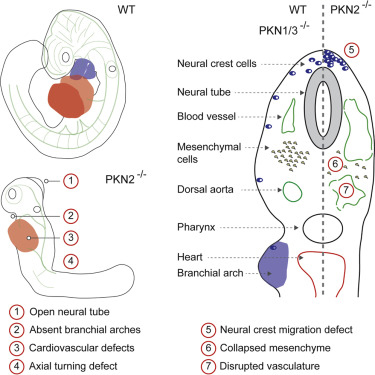|
|
Of protein kinases, embryos and cancer...
Protein kinases play an important role in how embryos develop. They also are becoming targets for cancer research.
Protein kinases (PKN) chemically add phosphate groups to proteins. By doing so, they can change the location of a protein target within a cell or change a protein's ability to bond to another protein.
Our genome contains about 500 kinase genes, which account for about 2% of all our genes. And up to 30% of human proteins can be modified by kinases.
Protein kinases regulate a majority of cell pathways by activating a specific receptor on the surface of a cell or perhaps a receptor located inside a cell. The process is known as signal transduction — or how cells communicate.
Receptors trigger a biochemical chain of events inside a cell, and depending on the cell, that chemical response can alter a cell's metabolism, shape, genes being expressed [turned on and made productive], or even a cells' ability to divide.
The study, in Cell Reports, was led by Queen Mary University of London (QMUL) and the Francis Crick Institute in the United Kingdom. It is the first knockout of a whole family of Protein Kinases — known as PKN1-3 — in mice, and reveals a link between them and congenital birth defects such as spina bifida.
"It is often the case that PKN proteins are essential in development but not in adulthood.
"Indeed, we've shown there's a limited need for this entire class of targets in adult mice. This is a positive sign for drug development against this family of proteins, where its members have been highjacked into cancers."
Angus Cameron PhD, Kinase Biology Laboratory, John Vane Science Centre, Barts Cancer Institute, Queen Mary University of London, UK
Of the kinase families the team knocked out, only one — PKN2 — appeared to be important in development and warrant more attention for cancer research. Knocking it out led to the death of mouse embryos by day 10 post fertilization.
The authors believe many of the functions attributed to all PKN families are possibly incorrect and hope their new research will raise the profile of this understudied kinase family — PKN1-3.
PKN proteins are increasingly recognised as important drug targets in cancer, and are currently being tested in pancreatic and breast cancers.
"The prospects for therapeutics targeting this [kinase] family are good, although further work is required to fully elaborate its role in adults."
Peter Parker PhD, Protein Phosphorylation Laboratory, Francis Crick Institute, London - and the Division of Cancer Studies, King’s College London, UK
Abstract Highlights
•PKN2, but not PKN1 or PKN3, is essential during mouse embryogenesis
•PKN2 knockout causes severe cardiovascular and morphogenetic abnormalities
•PKN2 is required for mesenchymal growth and neural crest migration in vivo
Summary
In animals, the protein kinase C (PKC) family has expanded into diversely regulated subgroups, including the Rho family-responsive PKN kinases. Here, we describe knockouts of all three mouse PKN isoforms and reveal that PKN2 loss results in lethality at embryonic day 10 (E10), with associated cardiovascular and morphogenetic defects. The cardiovascular phenotype was not recapitulated by conditional deletion of PKN2 in endothelial cells or the developing heart. In contrast, inducible systemic deletion of PKN2 after E7 provoked collapse of the embryonic mesoderm. Furthermore, mouse embryonic fibroblasts, which arise from the embryonic mesoderm, depend on PKN2 for proliferation and motility. These cellular defects are reflected in vivo as dependence on PKN2 for mesoderm proliferation and neural crest migration. We conclude that failure of the mesoderm to expand in the absence of PKN2 compromises cardiovascular integrity and development, resulting in lethality.
The research was funded by Cancer Research UK, Barts Cancer Institute, HEFCE, the Wellcome Trust, and the Royal Society.
For more information, please contact: Joel Winston
Public Relations Manager (School of Medicine and Dentistry)
Queen Mary University of London
This is an open access article under the CC BY license (http://creativecommons.org/licenses/by/4.0/).
About Queen Mary University of London
Queen Mary University of London (QMUL) is one of the UK's leading universities, and one of the largest institutions in the University of London, with 20,260 students from more than 150 countries.
Return to top of page
|
|
|
Jan 13, 2016 Fetal Timeline Maternal Timeline News News Archive

This is the first description of knockouts of a whole family of protein kinases (PKN1-3)
in mice. The research also reveals a joint role with the congenital birth defect spina bifida.
Image Credit: The Authors. Published by Elsevier Inc.
|
|
|
|



